11 Lara O’Donoghue on Wassily Kandinsky
Lara Grace O’Donoghue is a junior, double majoring in Philosophy and Law, Societies & Justice at the University of Washington. She primarily works with oil paint and ink but has recently become interested in textiles. Her current research is about the connection between art and the human condition and, in time, she hopes to attend law school to continue her exploration of human morality and behavior.
Wassily Kandinsky (1866-1944) was a Russian painter and art theorist. He was deputy director and a teacher at the Bauhaus, where he conducted classes on abstract form, color, and analytical drawing in the preliminary course from 1925 to 1933.[1] He also created published books such as ‘Concerning the Spiritual in Art’ in his development of art theory.[2]
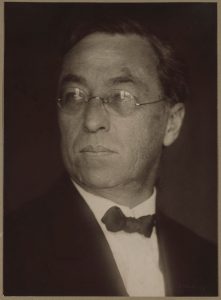
I have always been concerned with the question of what motivates human beings. Whether our actions are positive, negative, shocking, or wholly anticipated, I believe that they remain informed in all instances, nonetheless. It is the case, therefore, that I wanted to explore the possibility that art could have an effect on our actions and behavior. In deciding whom I wished to research, then, I placed a major emphasis on my own reaction to the works of various artists. Very quickly, I was drawn to Wassily Kandinsky. In a breath, I was in awe of his command of color; his ability to create such satisfying and complimentary compositions from seemingly random elements immediately caught my eye. This ability to elicit emotion through the careful use of lines, shapes, and planes is something to be spoken for. In particular, this provokes me to think critically about how abstract art can convey a clear message and allows me to construct a path to uncovering answers concerning art’s capacity to influence.
My own artwork, since having been exposed to Kandinsky, is certainly influenced by abstraction but is far more representational in its final form. Given this, I want to explore the transition from the abstract to the representational in three questions. The first being the question of how art can map the unknown features of the human condition. Secondly, I wish to address how abstract art can be used as a tool to convey explicit messages. Lastly, I seek to uncover how art can instigate behavioral changes and reshape the views of society. In doing so, I will draw a clear connection between art and human behavior. In this chapter, I will be providing examples of both my own artwork and Kandinsky’s, and I will analyze them to illustrate the techniques I am describing and to explain how they are relevant to the questions I have posed.
My first port of call is to address how Kandinsky approached art in itself and, in order to do so, it is imperative to understand the context of his time and of his roots. In his earlier, more representational works, it is clear to see that he was already extremely interested in bold and bright colors. He was influenced stylistically by “Henri Matisse and the Fauves”, but more significantly, by spirituality.[3] It is this spirituality that seemed to guide Kandinsky’s perspective on the world as it exists externally and also in those things which we cannot grasp by sight alone. Whereas the creative forces which exist in nature seem to function in terms of the “principle of concentric construction”, the creative forces in art follow an “uncentered construction”[4]. In other words, Kandinsky utilized art as a means of uncovering the unknowns of nature. What I intend to learn from this, then, is what we can assert to be the unknown features of the human condition.
I posit that the unknown features of the human condition are those elements of our being most ‘abstract’ and subjective within ourselves. In their rawest form, these would be emotions. However, emotions inform so many facets of our being which are equally as unknowable from an external perspective. Our implicit biases, our non-logical emotional-behavioral responses, our unconscious beliefs and our motivations are all enveloped in this world of uncentered construction. Now, a colleague of Kandinsky’s at the Bauhaus, Johannes Itten, is also known for his study of art and color theory with an emphasis on the spiritual, but there is something especially unique about Kandinsky that provides a means to move from the abstract to the explicit and representational. Kandinsky had a sensory disorder known as synesthesia. Synesthesia blends the senses to create a form of sensory experience that most of us aren’t privy to. Kandinsky was known to experience sound and color at the same time and, because of this, was able to provide us with his objective measure of the emotional;
“the sound of colors is so definite that it would be hard to find anyone who would express bright yellow with bass notes, or dark lake with the treble.” – Wassily Kandinsky.[5]
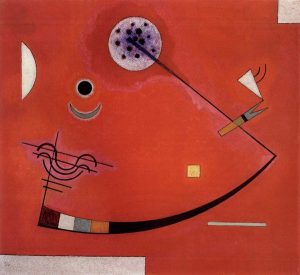
Using color as a metric for emotion, it is easier to comprehend how art can map the human condition. According to Kandinsky, yellow has the ability to disturb and blue awakens the highest spiritual aspirations.[6] In this way, we can see how color can not only convey to the viewer the emotions of the artist but can actually translate these emotions onto them. This is something I built upon in my art piece ‘anxiety’ which I created for my midterm assignment in Honors 211. As you can see below, there is a large triangular shape in my piece which appears to be black. However, upon closer inspection, the fabric is actually a dark navy plaid. This was an intentional decision informed by Kandinsky’s color theory, as I wanted to provoke viewers to double-take and experience a moment of confusion. Not only did this relay my own emotions to them, but my art was able to use color to encode emotional information, a feature I implemented based on Kandinsky’s techniques in his own artwork.
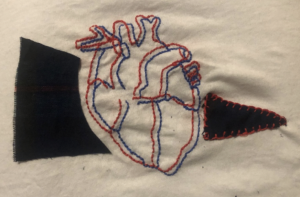
Color was not the only aspect of Kandinsky’s art that played a key role in conveying explicit information. Particularly during his time at the Bauhaus, he created incredible compositions using lines and shapes, geometric shapes being especially dominant in his pictorial vocabulary.[7] It is important, at this point, to situate Kandinsky further within his historical context. He was creating art at a time when collaging was very prominent and even informed further experimental art such as the matières produced at the Black Mountain College. In a sense, collaging is exactly what Kandinsky was doing with various compositional elements when painting. He was seeking to uncover a universal aesthetic language with overlapping flat planes and delineated forms.[8] In his abstract work, the lines and shapes bare no specific relationship to the plane upon which they are painted, thus creating the illusion that such elements are floating. Consider the following composition by Kandinsky and notice how the seemingly disjointed and random components all work together to create a sense of depth.
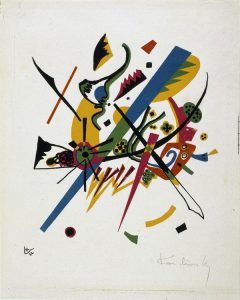
So, if we apply the removal of functions, we can take one step closer to conveying an explicit message. For example, if we strip something of its representational roles in order to understand ‘untouchable tonality’, we are able to convey a message that is, in turn, representational of our own untouchable features such as emotions.[9] I began with this concept when deciding the relational composition of my midterm project. My goal was always to create a literal message by translating my own emotions onto the viewer. I have explained how I used color to achieve this in part, but I also played with the concepts of Kandinsky’s aesthetic language. One message I wished to convey was that of discomfort, so, I used a representational image of a human heart and then sewed a second along a right-shifted plane. In doing so, I was able to manipulate the viewer into experiencing their own form of discomfort as they tried to come to grips with the almost 3D-effect I had created. This transition towards the representational from the basis of abstraction has led me one step closer to understanding the relationship between art and its ability to manipulate our behavior.
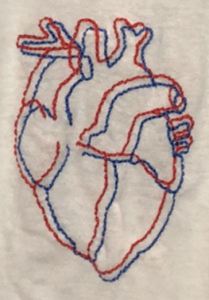
In order to answer my final question, of how art can instigate behavioral changes and reshape the views of society, I must first explain what Kandinsky believed the purpose of art to be. His view was that, in its simplest terms, art must disclose something to the viewer. It follows, then, that Kandinsky’s work restores the emotions of the universe upon being viewed.[10] I argue, however, that there is one key element that is required to disclose some explicit message through applying the concepts of abstract art: interaction. I believe that, if we are to create societal change via the means of art, it is not enough that such art merely exists or is viewed in passing. At the Bauhaus, Kandinsky conducted a wall painting workshop, which illustrates one way in which Kandinsky’s art could be interacted with. Wall art is large, imposing, and a feature of everyday life. As such, its role becomes somewhat of a performance and has the power to sow seeds of suggestion upon the viewer. A more literal example of performance created by Kandinsky is his performative art piece, ‘The Yellow Sound’, which addresses directly the relationship between color and sound that he experienced due to his synesthesia.
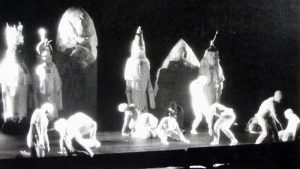
This final component, interaction, allows the viewer to internalize and reflect on the unmapped features of their being, which have been manipulated by the artist. An ‘interaction’ does not have to be as bold as taking part in or viewing a performance, however. I developed my midterm project, ‘Anxiety’, to be a piece that had to be worn. The act of wearing clothing is an interaction, so too is being forced to consider why such art exists on that clothing in the first place. For my time capsule project in Honors 211, I created an interaction that was a happy medium between covert and explicit interaction.
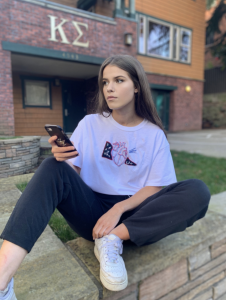
The time capsule I designed was sleek, modern, and minimalist, but once you embark on the act of opening it, you are confronted with a very clear message. The physical design of the capsule is juxtaposed with the contents within it, to create a sense of urgent panic in the viewer. Within the capsule, polaroid photographs displaying the most impactful images from 2020-21 are enclosed. Again, I specifically chose the medium of polaroid to add another layer of semi-representational messaging; the irony of my generation’s obsession for 90’s nostalgia, coexisting with the COVID-19 pandemic. I wanted this messaging to be so jarring, so much so that this emotional manipulation is taken to the extent of influencing change.
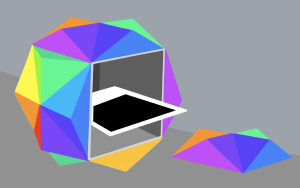
So, I have addressed three major components of art which I believe can, if applied correctly, influence behavioral and societal change. In using concepts based on abstractionist art theory and adapting these practices to work alongside the representational rather than in contrast to it, it is possible to elicit strong emotional responses in the viewer. Color, composition, and interaction are integral components of this process, and I have come to understand them through both my own perspective and through the study of Wassily Kandinsky. That being said, I believe we have seen this very practice used time and time again.
In the 21st century, this manipulation of art is a core ingredient in maintaining consumerist culture. Marketing relies heavily on this process; grocery stores are designed to place essential items at the back of the store whilst you are bombarded with bold colors and carefully tailored displays. Using the three techniques of careful color consideration, element composition, and method of interaction, we can be lulled into adapting our consumption behavior to fit a rhetoric that is being placed upon us. Similarly, the act of protesting oftentimes involves these techniques in an attempt to inspire social change – colorful placards, bold text, and a collage of different people joining together for one cause. I believe that these practices, although not new, are indicative of the truth behind the power of art to motivate change. Likewise, I believe through my research on Wassily Kandinsky, I have successfully uncovered why these techniques work. Art has the ability to map the unknown features of the human condition, abstract art can convey explicit messages, and when we combine this information together, art is capable of reshaping the actions and views of society.
Media Attributions
- Bauhaus-Archiv Berlin : © VG Bild-Kunst, Bonn 2016 © Bauhaus Kooperation is licensed under a CC BY (Attribution) license
- Kunstmuseum Bern, Stiftung Othmar Huber : © VG Bild-Kunst, Bonn 2016 © Bauhaus Kooperation is licensed under a CC BY (Attribution) license
- Photograph of Anxiety, by Lara O’Donoghue, Textiles, In progress. © Lara O'Donoghue is licensed under a CC BY-NC-ND (Attribution NonCommercial NoDerivatives) license
- Bauhaus-Archiv Berlin : © VG Bild-Kunst, Bonn 2016 © Bauhaus Kooperation is licensed under a CC BY (Attribution) license
- Photograph of “Anxiety”, by Lara O’Donoghue, Textiles, In progress. © Lara O'Donoghue is licensed under a CC BY-NC-ND (Attribution NonCommercial NoDerivatives) license
- Photograph of Kandinsky’s The Yellow Sound. Image sourced by the Guggenheim Museum. © Amanda Brown is licensed under a CC BY (Attribution) license
- Lara O’Donoghue Modelling “Anxiety” © Lara O'Donoghue, Cooper Rosner is licensed under a CC BY-NC-ND (Attribution NonCommercial NoDerivatives) license
- Lara O’Donoghue’s Time Capsule Design © Lara O'Donoghue is licensed under a CC BY-NC-ND (Attribution NonCommercial NoDerivatives) license
- Guggenheim Museum, “Kandinsky at the Bauhaus, 1922-1933”, September 10 2010, https://www.guggenheim.org/exhibition/kandinsky-at-the-bauhaus-1922-1933 ↵
- Bauhaus Kooperation, “Wassily Kandinsky”, https://www.bauhauskooperation.com/knowledge/the-bauhaus/people/masters-and-teachers/wassily-kandinsky/ ↵
- Christie’s, “Wassily Kandinsky: The road to abstraction”, October 10 2017, https://www.christies.com/features/Wassily-Kandinsky-10-things-to-know-8600-1.aspx ↵
- Michel Henry, “Seeing the Invisible: On Kandinsky”, 2009, April 15, Bloomsbury Publishing, London/ New York, Page 139 ↵
- Renée B. Miller, “Wassily Kandinsky’s Symphony of Colors”, Denver Art Museum, March 19 2014, https://www.denverartmuseum.org/en/blog/wassily-kandinskys-symphony-colors ↵
- Renée B. Miller, “Wassily Kandinsky’s Symphony of Colors”, Denver Art Museum, March 19 2014, https://www.denverartmuseum.org/en/blog/wassily-kandinskys-symphony-colors ↵
- Guggenheim Museum, “Kandinsky at the Bauhaus, 1922-1933”, September 10 2010, https://www.guggenheim.org/exhibition/kandinsky-at-the-bauhaus-1922-1933 ↵
- Guggenheim Museum, “Kandinsky at the Bauhaus, 1922-1933”, September 10 2010, https://www.guggenheim.org/exhibition/kandinsky-at-the-bauhaus-1922-1933 ↵
- Michel Henry, “Seeing the Invisible: On Kandinsky”, 2009, April 15, Bloomsbury Publishing, London/ New York, Page 38 ↵
- Michel Henry, “Seeing the Invisible: On Kandinsky”, 2009, April 15, Bloomsbury Publishing, London/ New York, Page 38 ↵
- Amanda Brown, “Photograph of Kandinsky’s “The Yellow Sound (Der Gelbe Klang)””, Guggenheim Museum, December 16 2009, https://www.guggenheim.org/blogs/findings/photograph-of-kandinskys-the-yellow-sound-der-gelbe-klang ↵

